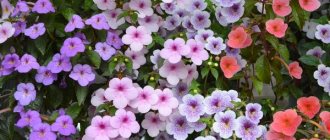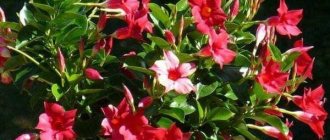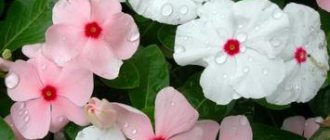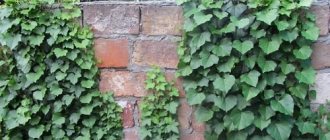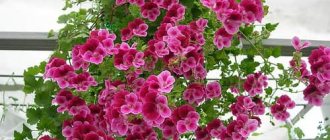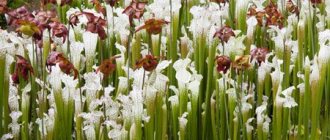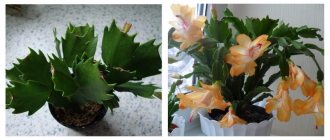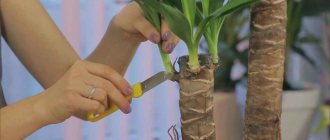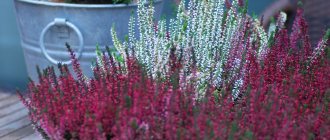Botanical description
Areca belongs to the genus Palmaceae and has about 50 species of varying heights. In nature, there are both miniature plants (35 cm) and giant ones, reaching a height of 20 meters.
Areca is a tree with one or more thin tubular stems with ring-shaped scars at the base. The foliage is located at the top of the trunk and has a rich, bright green hue.
Densely arranged leaf plates resemble a comb. Straight, dissected leaves look like feathers.
The cob-shaped inflorescences produce white flowers, divided into staminate (male) and pistillate (female). The fruits are red-yellow berries, inside of which you can see horn-shaped seeds filled with protein.
Gardeners often confuse areca with palm trees such as Howea and Chamaedorea. Both of these species belong to the Arecaceae family. Outwardly, these types are similar, but there are also differences.
In areca, the number of leaf segments varies between 4-6 plates. Whereas Hamedorea has much more of them. The leaves are located in the upper part of the trunk, while in howea they grow from the base. Hamedorea is much lower than areca. Areca has soft leaves, while Howea's fishtail-like foliage is tough.
The flowers of areca and chamedorea also differ: the inflorescences of the first are densely arranged and have a yellowish color, while the panicle of chamedorea is loose.
Beautiful areca in the photo:
Areca catechu variety: photo and description
The Areca catechu variety grows in most tropical countries in the Pacific, Asia and East Africa. This type of palm is also often called the betel tree because its fruits are often chewed along with betel leaves. When compared with its other brethren, the size of the palm tree is quite small - only 20 meters, and the stem is even smaller - only 10 cm in diameter. Large, feathery leaves can reach two meters. Below are photos of areca catechu:
The Areca catechu palm is often used for landscaping their gardens and plots. It is also used in large spaces such as hotels or large shopping centers. But it’s true that it grows very slowly indoors, which means you’re unlikely to get any fruit from it.
The constant use of areca seeds, as in other varieties, is addictive - this phenomenon is typical for residents of Thailand, Taiwan, Vietnam, the Philippines, Malaysia and India. If used frequently, it causes oral cancer.
The Areca flower can dry out if the air is too dry or cold, or the flower simply does not have enough moisture.
Kinds
Despite the fact that the areca palm has dozens of species, only a small part of them are cultivated at home. The most common types are Areha kateku, yellowish and three-stamened.
Areca catechu
Areca catechu or betel palm is the largest of all arecaceae species. It originates from the Malay Peninsula and the Malay Archipelago in Eastern India. A distinctive feature of catechu is the presence of one stem, reaching a height of 20-25 m, and a diameter of only 50 to 120 mm.
On the surface of the smooth trunk there are numerous ring scars left by fallen leaves. Arc-curved leaf segments 2 meters long are concentrated at the top of the trunk. The basis of the leaf plates is made up of densely spaced leaves 30 mm wide and about 60 cm long. The surface of the leaves is smooth, glossy, with veins running along them, and the ends are pointed.
Inflorescences formed in the axils of the leaves produce white flowers that emit a pleasant aroma. The fruits of betel nut, which have reddish-yellow seeds, are called batel nut. When grown at home, the height of the plant does not exceed 3 meters.
Chrysolidocarpus yellowish
Areca lutescens is a medium-sized species of arecaceae, not exceeding 10 m in height. It is also called yellowing dipsis. Originally grown in Malaysia.
The straight, graceful stem with ring-shaped scars is covered with one and a half meter long pinnate leaf plates curved in the form of an arc. The lancet-shaped leaves are planted quite close to each other. Their width is about 3 cm, and their length is 20-35 cm.
This species is distinguished by its yellowish foliage color and highly branched base. Thanks to this, the palm tree resembles a bush; the height at home does not exceed 2 m.
Trekhtychinkovaya
Areca triandra originates from the Indian Malay Peninsula. This is a double-stemmed plant about 3 m tall. The trunks are 25-50 mm in diameter, covered with scars in the form of rings.
The one-and-a-half-meter leaf segments are straight, resembling feathers, and consist of leaflets 35 mm wide and 50-90 cm long. The inflorescences, located in the leaf axils, reach a length of up to 100 cm and have snow-white flowers with a lemon aroma. The fruits are small, 25 mm long.
Home care
An areca palm grown in an apartment or office does not reach its natural size. But still, its dimensions are quite large, so you will need to take care of a spacious place for it.
Caring for areca at home is not difficult. It is enough to follow some recommendations for the plant to grow steadily, be healthy and acquire a dense crown.
Place, lighting, soil
Areca is a tropical plant accustomed to bright light. However, sunlight should be diffused so as not to harm the crop. Young trees are particularly susceptible to exposure to ultraviolet rays. If you receive burns, it will be very difficult to save the palm tree.
After reaching 6 years of age, the palm tree is not so susceptible to sunlight, and burns are not so destructive for it. The only thing is that the plant will change the color of the leaves when exposed to ultraviolet light.
In order for a symmetrical crown to form, the plant must be illuminated from all sides. Otherwise, every 2 weeks you will need to turn the flower 180°.
It is not recommended to place the palm tree near heating devices or in a draft. The most optimal place may be a place located away from radiators and window openings, but sufficiently illuminated.
In summer, during periods of particularly active sun, the plant should be shaded.
In the first few days after purchase, the palm tree should get used to the new conditions, but later it will need to be transplanted into a suitable container. The soil should be neutral or acidic. It is desirable that the soil be loose to ensure stable drainage of excess liquid. The substrate should include:
- perlite;
- pebbles;
- sand;
- charcoal;
- coarse peat;
- bone flour;
- pumice.
If the soil is selected correctly, water after watering, having seeped through the earthen ball, will come out through the drainage path. If this process takes a long time, then the substrate is not suitable for growing areca.
Temperature, air humidity
The areca palm grows and develops at temperatures ranging from 30-35°C. It is difficult to ensure such a temperature at home, so it is necessary to maintain at least 20-25°C in the room where the areca is located.
Prolonged exposure of a palm tree at temperatures of 0 degrees and below leads to the death of the plant. If adult specimens can survive for 2-3 days at temperatures from 0 to -6°, then young bushes die at such indicators.
The natural habitat of the crop is characterized by high humidity. Dry air negatively affects the vital indicators of the palm tree: leaf segments begin to dry out, decreasing in size, and the ends of the leaves dry out. This phenomenon is usually typical in winter during the operation of heating devices that dry the air.
Systematic spraying and the use of special air humidifiers will help to avoid damage to the plant. You can simply cover the batteries with damp towels.
Watering
Most often, the areca palm dies due to excessive watering. Watering should be done after the top layer of soil has dried to a depth of at least 3 cm.
You need to moisten the soil carefully so as not to get it on the ground part of the bush.
It is advisable to water the crop only with rain or filtered water. When using tap water, let it sit for at least a day.
Water that has accumulated in the tray after watering should be removed so that the palm tree is not in water, otherwise the roots will begin to rot and the plant will die.
Top dressing
Indoor areca needs regular feeding of the soil. Fertilizers are applied all year round: in spring and summer - every 14 days, and in autumn and winter - once a month.
A lack of certain nutrients in the soil can impair the decorative properties of a crop or provoke the development of dangerous diseases.
Complex mineral fertilizer intended for palm trees is used as fertilizing. In parallel with the root feeding, foliar feeding is carried out during the growing season, spraying the crown with a nutrient solution.
Video about caring for areca at home:
Rest period
Lack of light and lower humidity levels in winter force areca to slow down its development. Typically this period lasts from October to February.
The conditions of detention remain the same. The only thing is that you will need to reduce the intensity of watering so as not to provoke rotting of the roots.
Trimming
Areca care involves regular pruning of injured or dead leaf segments. In this case, it is necessary to wait until the petioles dry completely so that the plant has time to draw out all the nutrients from the fading leaves.
Root shoots that interfere with the growth of the main trunk must also be pruned. To form a beautiful crown, the foliage that bends below the level of the pot is carefully cut off.
Transfer
As the bush grows, the root system increases and requires more capacity. This can be determined by the drainage holes of the pot: if the roots are visible through them, replanting is required. Typically, young specimens are replanted once a year, and adults – every 3 years.
The best time for transplantation is April.
When transshipping plants, the following rules must be observed:
- Moisten the soil.
- Pull out the flower along with the earthen lump, being careful not to damage the root.
- Place the bush in the center of the pot, filling the empty space with fresh substrate, maintaining the level of the root collar.
Detected rotten areas of the root system are cut off, the old soil mixture is completely removed, and the cut areas are treated with charcoal.
For the first 7 days, the transplanted plant should be protected from direct sunlight by shading it.
Soil requirements and planting
Yuca flower: how to care for yucca at home and in the garden
The optimal soil substrate is one that has a neutral or acidic reaction. Experienced gardeners recommend purchasing ready-made soil mixture for palm trees or making your own substrate. To do this you will need:
- Bone flour;
- Pine bark;
- Charcoal;
- Pebbles or crushed stone;
- Pumice;
- Peat.
All components are mixed and poured into the pot. Holes must be drilled at its bottom to drain excess liquid after watering. The bottom layer is pebbles or crushed stone. Replanting a flower is carried out at a time when the root system has grown to the entire container.
Replanting is best done in the second ten days of April. During the transplantation procedure, be sure to transfer the plant along with a lump of earth, without removing it from the roots.
When choosing a container for replanting, you should be very careful; purchase a pot only according to the size of the plant. The soil level should not be changed. After the transplant procedure is completed, proper care is also important. Fertilize throughout the entire growing season using flower fertilizers (which can be purchased at specialized sales points).
Thanks to proper transplantation, watering, and placing the plant in the right place, you can achieve good growth, development and flowering of the plant. The areca palm will be a wonderful addition not only to an apartment, but also to an office. You just need to observe the conditions of humidity and temperature to ensure normal development of the deciduous mass.
Reproduction
Areca palm propagation is carried out in two ways: using seeds and dividing the bush.
Sowing of seeds is carried out in spring or summer. Before sowing, the seed material is dipped in a sulfuric acid solution for 10 minutes, then the pots are filled with soil consisting of peat sand.
Before planting the seeds, the soil is moistened, the seeds are placed 20 mm deep. If the air temperature fluctuates between 27-30°C, seedlings can be expected within 4-8 weeks. At lower temperatures, the first shoots appear only after 3-4 months.
The appearance of the first true leaf is a signal for transplanting young shoots into separate containers.
If there are root shoots in an adult crop, propagation can be carried out by dividing the bush. To do this, the shoot is cut off and placed in a separate pot, taking fertilized, loose soil, including turf soil (2 parts), leaf humus and sand (1 part each).
After planting, the soil is moistened. If all the rules are followed, 15-20 days are enough for the shoots to take root.
Rooted bushes must be fed with complex mineral fertilizers, taking half the dose specified in the manufacturer's instructions.
Bloom
In nature, areca blooms starting from the third year of life, after the completion of the formation of an extensive crown. On the cob-shaped inflorescences there are male and female flowers that have a white or creamy tint. After flowering, orange horn-shaped fruits are formed.
At home, the areca palm tree practically does not bloom or blooms very rarely. To do this, you need to provide proper care and the necessary living conditions.
Features of the Areca Palm
Areca stems are usually thin with a cylinder of tubular-shaped sheaths. The foliage of this plant is pinnately dissected. During flowering, an inflorescence-cob appears, its upper part consists of staminate male flowers, and the lower part consists of female pistillate flowers. The fruit is a fibrous berry containing seeds inside.
Areca palm at home
Diseases and pests
Incorrect or improper care of the areca palm at home can provoke the development of diseases.
Most often, a houseplant suffers from root rot, which appears due to excessively intensive watering. The first signs of the disease are reddish-brown spots protruding on the leaf segments. If you delay the start of treatment, the spots will begin to increase in size and merge.
If symptoms are detected, the bush should be sprayed with a fungicide, repeating the treatment after 7-10 days.
Harmful insects also cause a lot of concern to the palm tree:
- mealybug;
- spider mite;
- whitefly;
- scale insect
Treatment with insecticides will help protect against insect attacks. Before spraying, it is necessary to remove the insect with cotton wool soaked in an alcohol solution. To clean the most difficult to reach places, use a toothbrush or cotton swab.
To combat spider mites, acaricide insecticides are used.
Leaf care
When watering, splashes of water can contaminate the leaf cover; they must be cleaned using a flannel pre-moistened in a 5 percent solution of oxalic acid, followed by a warm shower and wiping the leaf cover dry. The plant also needs regular dust removal every two weeks by wiping the palm leaf cover with a damp flannel.
You should not use chemical cleaners; the likelihood of leaf chlorosis increases.
The plant can be damaged by pests such as spider mites, mealybugs, scale insects, thrips and whiteflies.
Mistakes and care problems
Poor care of a palm tree worsens its appearance, and in some cases the plant may even die.
The main mistakes made during the growing process are presented in the following table:
| Problems | Causes |
| Yellowing, drying of leaves | Low humidity or insufficient watering |
| Shredding, pale foliage | Lack of light |
| Darkening, wilting of leaf blades | Decrease in air temperature |
| Light spots on the surface of the leaves | Sunburn |
| The appearance of yellow or orange spots on the surface of the foliage, curling, drying of leaves | Potassium deficiency |
| Changing the color of the palm tree to light green, stopping the growth of the plant | Nitrogen starvation |
| Light yellow stripe on old foliage running along the edge of the blade | Magnesium deficiency |
| Reducing the size of sheet plates followed by drying | Manganese deficiency, high soil acidity |
| Small necrotic spots on the surface of leaves | Insufficient zinc |
| Dark spots on leaves | Excess moisture |
Typical problems
Sometimes areca leaves turn yellow or dry out . This indicates improper watering of the plant. Adjust the watering and everything will return to normal. To prevent the leaves from drying out, protect them from direct sunlight.
The light should be diffused and uniform. Move the plant and turn it in different directions towards the light, one at a time.
To prevent the roots from rotting, do not overwater the areca plant frequently. This will cause brown spots to appear on the leaves .
Browned tips indicate dry air or cold. Spray your palm tree regularly. Transfer to a warm place.
